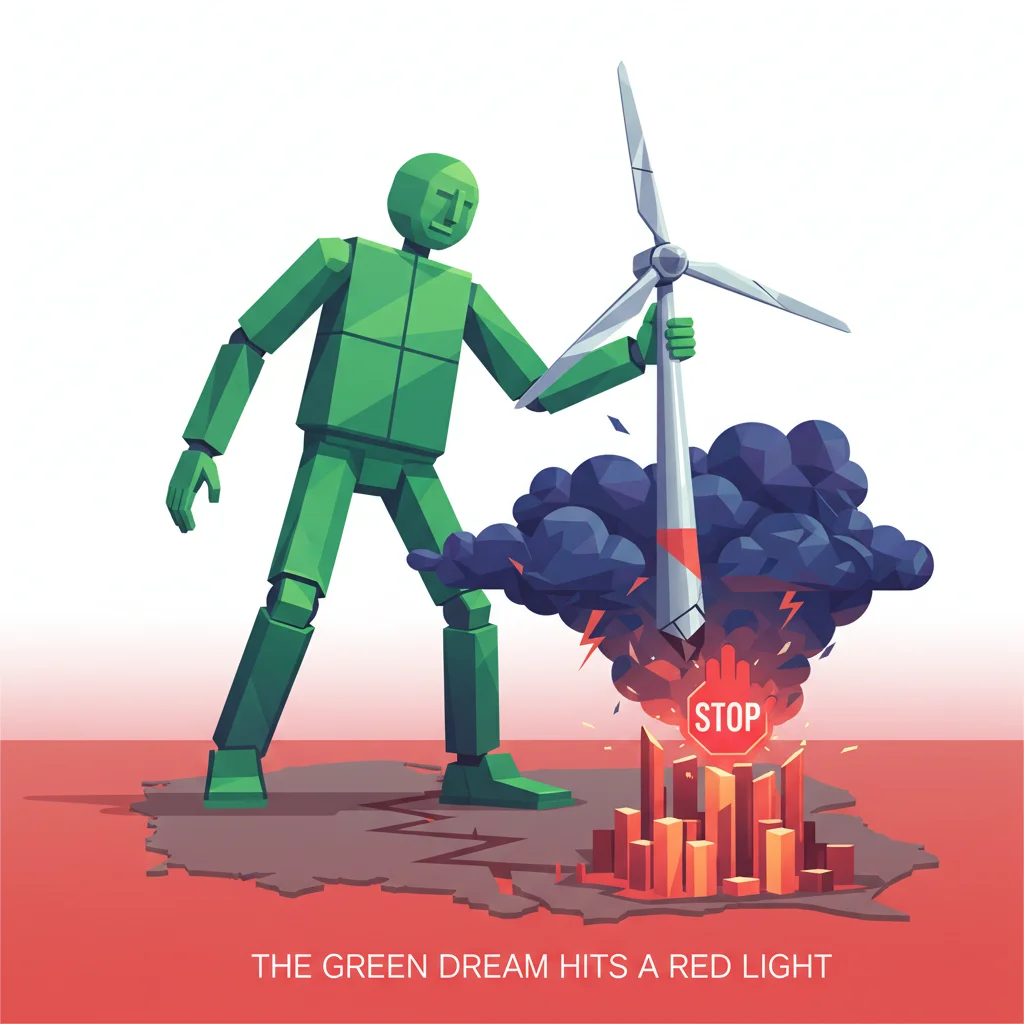
A Green Giant Stumbles: Why Vestas’ Polish Pause Signals a Storm for European Wind Energy
The Green Dream Hits a Red Light
The narrative of Europe’s green transition has long been one of unstoppable momentum. A future powered by clean energy, spearheaded by towering offshore wind turbines, seemed not just possible, but inevitable. However, a recent development from the heart of the industry has sent a chilling gust through the sector, forcing a moment of sober reflection. Danish wind turbine giant Vestas has officially shelved plans for a landmark €2 billion factory in Szczecin, Poland. This facility was poised to be a cornerstone of the European supply chain, producing the colossal blades for the company’s next-generation offshore turbines.
On the surface, this is a corporate decision about a single factory. But dig deeper, and it reveals a complex web of challenges threatening the very foundations of Europe’s renewable energy ambitions. This isn’t just a story about wind turbines; it’s a critical case study in industrial policy, project finance, and the harsh realities of macro-economics colliding with climate goals. For investors, policymakers, and business leaders, the Vestas decision is a canary in the coal mine, signaling that the path to a green economy is far more turbulent than previously forecast.
Deconstructing the Decision: More Than Just a Pause
Vestas’ move to suspend the investment in its Polish nacelle assembly plant is a direct response to a stark reality: a lack of firm orders. The factory was intended to build components for the company’s flagship V236-15.0 MW offshore turbine, a marvel of engineering designed to be a game-changer in energy production. Yet, despite the hype, the order book remains troublingly thin. According to the company, the “business case is no longer solid” due to “insufficient firm commitments” for these new, larger turbines (source).
This decision is a significant blow to Poland, which had ambitions of becoming a central hub for the Baltic Sea’s burgeoning offshore wind industry. The plant was expected to create jobs, spur local economic growth, and position the nation as a key player in the green supply chain. Now, that vision is on indefinite hold.
But the real story lies in the “why.” This isn’t a failure of technology or a lack of ambition. It’s a symptom of a sector-wide malaise, a perfect storm of economic headwinds that have turned profitable-on-paper projects into financial nightmares. Understanding these forces is crucial for anyone involved in energy investing, infrastructure, or the broader stock market.
The Siren's Call: Why Aberdeen is Sounding the Alarm on Private Assets for UK Retail Investors
The Perfect Storm: The Economic Headwinds Battering Wind Power
The green energy sector, once a darling of investors, is now navigating treacherous waters. Several powerful forces have converged to squeeze profitability and create crippling uncertainty.
1. Inflation and Supply Chain Volatility
The post-pandemic world has been defined by soaring inflation and chaotic supply chains. The cost of raw materials essential for wind turbines—particularly steel—has skyrocketed. Coupled with rising logistics and labor costs, the initial financial models for many wind farm projects have been rendered obsolete. What looked like a profitable investment in 2020 now faces razor-thin, or even negative, margins. This volatility makes long-term capital allocation, a cornerstone of sound finance, incredibly difficult.
2. The Double-Edged Sword of Interest Rates
To combat inflation, central banks across the globe have aggressively hiked interest rates. For a capital-intensive industry like offshore wind, this is a devastating blow. These projects require billions in upfront investing, financed through massive loans. As the cost of borrowing rises, the overall project cost balloons, often to the point of being unviable. The world of banking has become far more cautious, demanding higher returns to compensate for increased risk, putting many projects on ice.
3. The Permitting Labyrinth
While the ambition is green, the bureaucracy is red tape. The process of securing permits for large-scale energy projects in Europe is notoriously slow and complex. This administrative drag creates years of uncertainty, a factor that is poison to investors. Capital sits idle, risks accumulate, and the window of opportunity can close before a single shovel hits the ground.
4. A Flawed Auction System
Many European governments award contracts for offshore wind farms through auctions where the lowest bid wins. While this seems beneficial for consumers, it has created a “race to the bottom” culture. Developers, eager to win contracts, submit hyper-aggressive bids based on optimistic cost projections. When inflation and interest rates inevitably rise, those bids become unsustainable, leading to project cancellations and supply chain instability. This is a classic lesson in economics: prioritizing the lowest price above all else can destroy the long-term health of the market itself.
The Technology Gamble: Bigger Isn’t Always Better
At the heart of the Vestas story is the V236-15.0 MW turbine. The industry has been locked in a technological arms race to build ever-larger turbines. The logic is sound: a single, more powerful turbine requires less foundational work, fewer connections, and less maintenance per megawatt generated, driving down the long-term cost of energy.
The scale of these new machines is staggering, as a simple comparison shows:
| Feature | Typical Turbine (2010s) | Vestas V236-15.0 MW |
|---|---|---|
| Rotor Diameter | ~120 meters | 236 meters |
| Swept Area | ~11,300 m² | 43,742 m² (source) |
| Power Capacity | 3-6 MW | 15 MW |
| Annual Energy Production | Enough for ~3,000 homes | Enough for ~20,000 homes |
However, this race comes with immense risk. The research and development costs are astronomical. Manufacturers like Vestas are making a multi-billion-dollar bet that developers will rapidly adopt this new technology. But if the developers themselves are struggling with project financing and permitting, they can’t place the firm orders needed to justify the massive capital expenditure on new factories. Vestas has built the next-generation sports car, but the customers are stuck in traffic, unable to afford the fuel. This disconnect between technological advancement and market readiness is a core tension in the current crisis.
The Great Thaw: Why Europe's IPO Market is Roaring Back to Life in 2024
The Ripple Effect: What This Means for the Broader Economy
The tremors from Vestas’ decision in Poland will be felt far and wide, impacting everything from individual investment portfolios to national energy strategies.
For the Stock Market and Investors
The news is a bearish signal for the entire renewable energy sector. Companies like Vestas, Siemens Gamesa, and GE Vernova have all seen their valuations battered as they struggle with profitability. Investors who piled into green energy ETFs and stocks based on the promise of explosive growth are now facing a harsh reality check. The focus in trading circles is shifting from top-line growth to bottom-line profitability and balance sheet strength. ESG (Environmental, Social, and Governance) investing is being forced to mature, demanding not just green credentials but also sound financial footing.
For the European Economy and Energy Security
A weakened renewable energy supply chain is a direct threat to Europe’s strategic goals. The continent is desperate to achieve energy independence, particularly from Russian gas. A robust domestic manufacturing base for wind turbines is critical to this mission. If European manufacturers falter, it opens the door for state-subsidized Chinese competitors to dominate the market, creating new geopolitical dependencies. This is no longer just an environmental issue; it’s a matter of economic security.
For the Future of Green Finance
The era of easy money for green projects is over. The banking and finance sectors will now demand much more rigorous risk assessment. Project developers will need to provide greater certainty on costs, timelines, and offtake agreements. This could spur innovation in financial technology, creating new platforms for syndicated loans, risk modeling, and even using technologies like blockchain for transparent and verifiable supply chain management to reassure lenders. The cost of capital for renewables will likely rise, but the projects that do get funded will be more robust and resilient.
Digital Dollars, Analog Banks: The Hidden Forces Stalling America's Financial Future
Charting a New Course: Rebuilding Momentum
While the outlook seems grim, this crisis also presents an opportunity to rebuild the industry on a more sustainable foundation. Several steps are essential:
- Policy and Auction Reform: Governments must move away from simple price-based auctions. New models should include non-price criteria, such as a commitment to local supply chains, innovation, and environmental standards. This creates a healthier market that doesn’t just reward the cheapest bid but the most resilient one.
- Streamlining Permitting: A concerted effort is needed to simplify and accelerate the permitting process across Europe. Creating “green fast lanes” for critical infrastructure projects is essential to unlock investment.
- Government-Industry Collaboration: Closer partnerships are needed to de-risk investments. This could include price stability mechanisms, offtake guarantees, or co-investment in critical supply chain infrastructure.
Conclusion: A Necessary Reckoning
Vestas’ decision to halt its Polish factory is not an isolated event but a powerful symbol of an industry at a crossroads. The initial, exuberant dash for green energy has met the unforgiving reality of global economics. The headwinds of inflation, high interest rates, and policy bottlenecks have exposed the fragility of a supply chain built on optimistic assumptions.
For investors and business leaders, the key takeaway is that the green transition will not be a smooth, linear journey. It will be fraught with volatility and marked by periods of correction. Success in this new era requires a shift in mindset—from blind optimism to calculated realism. The future of renewable energy depends not just on building bigger turbines, but on building a more resilient and economically sound foundation to support them. The storm is here, and only those who adapt will be left standing to harness the winds of the future.


